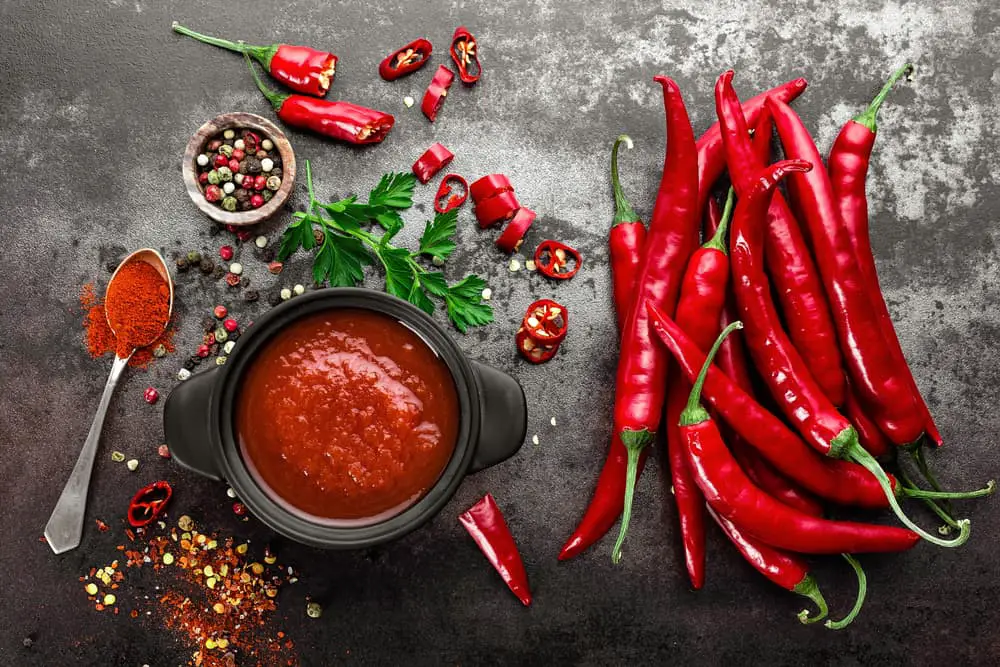Last Updated on 22nd June 2023 by
If you enjoy adding some heat to your food, then you probably use red chilli pepper in all your spicy dishes.
But what happens if, say, you run out of your magic maker? Are there any alternatives? Or would you have to just give up that delicious burn?
Okay okay, there’s no reason to freak out! You can use several other types of peppers in place of red chilli pepper. In fact, i’ll be discussing 5 substitutes for red chilli pepper in this article.
Additionally, we’ll be providing you with substitutes for crushed red pepper flakes, chilli powder, red chilli pepper paste, and more! So without further ado, let’s hop in!
Table of Contents
What is Red Chilli Pepper?
If you’ve ever felt like a dragon breathing fire after taking a bite of your food, then it’s probably made with some red chilli pepper. There are various types of chilli peppers, but the red hot ones are the most commonly used in our restaurants and found in our local stores.
So where do these hot heads come from? Well, red chilli peppers are the fruits of the Capsicum pepper plant.
They contain carbohydrates as well as traces of protein and fibre. They’re also packed with vitamins and minerals, but most people don’t count on them for nutritional value because they only eat very small bits.
Red chilli pepper gives food a unique, spicy taste with hints of sweetness, sourness, and smokiness. So, you can add it to a variety of dishes from pasta and salsa to seafood and stew.
What Can I Substitute for Red Chilli Pepper?
When looking for a substitute for red chilli pepper, you want to use peppers with a similar level of heat and sweetness/smokiness profile.
The following 5 peppers work well instead of red chilli pepper in recipes:
1. Serrano Pepper
Harvested while still green, serrano pepper is a bit hotter than red chilli pepper. Actually, serrano is one of the hottest chilli peppers that offer a milder taste.
Used in the Southwest of the United States, serrano pepper isn’t as popular as red chilli or jalapeno. Before adding serrano to your next recipe, be sure to tweak the measures to compensate for the difference in heat level.
2. Jalapeno Pepper
With a heat level varying from medium hot to very hot, jalapenos are quite a common edition to add to dishes nowadays. Jalapeno peppers are smooth and usually dark green, but sometimes they’re red as well.
Jalapenos are popular all around the world, especially in Mexican cuisine. These peppers contain a lot of nutrients with numerous health benefits.
3. Cayenne Pepper
Do you know the iconic shape of red chilli where the pepper is thin and curved with a pointy end? Well, that’s cayenne pepper for you!
The level of heat or spice of cayenne peppers widely varies from mild to strong depending on the type of the pepper (Carolina cayenne pepper, golden cayenne peppers, etc) and its growing conditions. Cayenne peppers are available in both fresh and dried forms in food stores.
4. Pequin Chilli Pepper
On the shorter, more rectangular side, we have the pequin chilli pepper that measures around one inch long. These hot chillis aren’t as common as other red chilli pepper substitutes on our list because their cultivation is limited.
Pequin chilli pepper is usually smoked over wood to deliver its signature flavour.
5. Tien Tsin Chilli Pepper
Originating from Northern China, these chilli peppers were actually named after the province in which they were grown. They have a shiny, bright red appearance and are extremely hot.
Also called Chinese red peppers, Tien Tsin chillis are used in many Chinese dishes including Szechuan and Kung Pao chicken. Be careful not to add too much of these substituting.
Can You Substitute Chilli Powder for Crushed Red Pepper Flakes?
The preferred substitute for crushed red pepper flakes is ground cayenne pepper, but if you don’t have that on hand, then chilli powder is probably the next best thing.
chilli powder, much similar to chilli flakes, includes a mixture of various types of dried hot peppers. However, instead of containing spicy cayenne pepper as in crushed red pepper flakes, chilli powder typically use peppers with mild to low heat.
If you decide to go for chilli powder in place of crushed pepper flakes, you’ll need to add a couple of extra dashes to achieve the same level of spice.
Can You Substitute Red Pepper Flakes for Chilli Flakes?
“Red pepper flakes” is just another name for chilli flakes, so yes, you can use them to substitute one another. Both spices are made by crushing different types of red chilli peppers, often with cayenne pepper as a base.
Can You Substitute Red Pepper Flakes for Chilli Powder?
If you run out of chilli powder, then turn to your stock of red pepper flakes for help. Red pepper flakes are an excellent substitute for chilli powder, particularly when you further grind them up.
Using a mortar and pestle or an electric spice grinder, finely grind your red pepper flakes until they become powder. Keep in mind that red pepper flakes are a bit hotter than chilli powder.
What Can I Substitute for Red Chilli Pepper Paste?
There are several options available when it comes to substituting red chilli pepper paste, here are our favourites:
- An international chilli paste – at the supermarket, don’t limit your search to bottles that simply carry a “red chilli pepper paste” label. Instead, look in the international section for chilli pastes that have exotic names such as harissa, sambal oelek, or gochujang.
These are all chilli pepper pastes, just from different backgrounds where each has a unique flavor. For example, sambal oelek is the simplest and mildest out of the three, so it should be great in place of simple chilli paste. If you need a more spiced kick, you can go for harissa or gochujang since they’re much hotter.
- A DIY chilli paste – if you can’t buy it, then make it! The ultimate substitute for red chilli pepper paste can simply be one that you make right at home. The process is super easy and other than some fresh chilli peppers, all the ingredients you need are probably sitting in your pantry right now.
Simple Guide to Making Homemade Chilli Paste:
Instructions
- Finely chop some fresh chilli peppers, garlic, and onions in your food processor. You can throw in additional veggies if you wish.
- Put a little olive oil in a pot along with the chopped mixture.
- Cook for 20 minutes on low heat while letting it simmer.
- Add any extra preferred seasonings and cook for 5 more minutes.
- Pour the concoction into a jar and allow it to cool slightly.
- Refrigerate or use it to cook.
- Red pepper flakes – if you enjoy spicy food, chances are you currently have a bottle of red pepper flakes in your pantry. While you can simply use them to add some heat to your meal, you can also make red pepper flakes into a paste for a thicker format.
The recipe yields a spicy and sweet chilli paste using only 3 ingredients: crushed red pepper flakes, soy sauce, and sugar. Here’s how you can make it:
- Mix a tablespoon of the red pepper flakes with a dash of soy sauce and a few pinches of sugar to provide some thickness.
- Muddle the mixture to create a paste-like consistency.
- Hot Sauce – red chilli pepper paste isn’t the same as hot sauce, but when you need a substitute to add heat, hot sauce can be a good solution. There are 2 major differences between chilli paste and hot sauce.
Thickness is the first and most obvious one. Just by looking you can tell that hot sauce is a lot thinner than paste. So if you need the heat and your recipe doesn’t ming the more runny consistency, some hot sauce should do the trick.
The amount of vinegar added is the second main difference, especially if we’re talking about Louisiana-style hot sauces (such as Tobasco) as they’re traditionally vinegar-based. chilli pastes don’t usually carry the tang of vinegar.
For this reason, you need a hot sauce that’s light on the vinegar to substitute for red chilli pepper paste. As such, we recommend sriracha sauce to get the closest possible taste to chilli paste since it’s thicker and packed with chilli pepper flavour.
Can You Substitute Red Chilli Pepper for Paprika?
Made by grinding dried red peppers, red chilli pepper flakes are hot with a level of spiciness ranging from mild to strong depending on how they were made.
Similar to paprika, red chilli pepper can offer a sweet or smoky flavour. As a result, you can use red chilli pepper flakes instead of paprika, but since it’s much hotter, you’ll need to adjust the recipe accordingly.
Wrap Up
We hope this article has given you the confidence to experiment with different types of peppers and find the perfect substitute for red chilli pepper in your recipes. Remember, there are many options available, so don’t be afraid to explore and find the one that best suits your taste buds and heat tolerance.
Now that you’ve reached the end of the article, we’d love to hear your thoughts and experiences. Do you have a go-to substitute for red chilli pepper that wasn’t mentioned here? Have you tried any of the alternatives we’ve discussed? Let us know by leaving a comment below! If you prefer, you can also reach out to me directly to share your insights or ask any questions.
Happy cooking, and enjoy your spicy culinary adventures!
FAQs
What is the same as red chili pepper?
In culinary terms, “red chili pepper” can be interchangeable with terms like “cayenne pepper” or “jalapeño” depending on the context and heat level required. It’s a hot, pungent spice made from various types of capsicum plants. Used worldwide, it adds heat and flavour to a wide array of dishes.
How much red pepper flakes equals one red chili pepper?
As a rough guideline, one small red chilli pepper may be substituted with half a teaspoon of red pepper flakes. However, the heat can vary depending on the type of chilli and the pepper flakes used. Always adjust according to taste and spice tolerance to achieve the desired flavour profile.
Is red chili pepper the same as cayenne pepper?
Red chili pepper is a general term that includes various types of capsicum, whereas cayenne pepper is a specific type of red chili pepper known for its potent heat. Though similar, they aren’t exactly the same. The heat level, flavour, and size can vary, so they may not always be interchangeable in recipes.
I'm Pauline, a mother of four grown children, my passion for cooking stemmed from the joy i get cooking for my family. I love to try new dishes, especially when dining out but creating and sharing my own recipes is my favourite thing to do!



transhipped
Friday 21st of February 2025
Auz4SJdYfL1